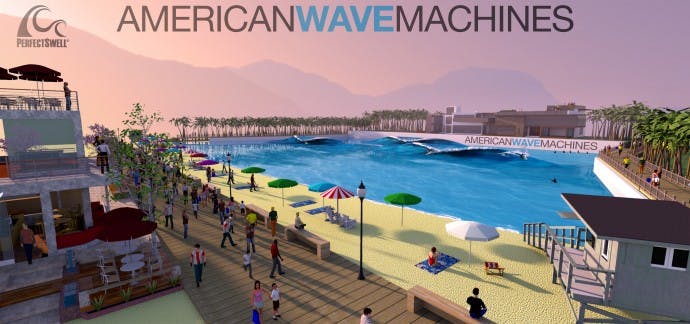
QUARTZ | 12-20-2013
By: Todd Woody at Quartz
Bruce McFarland’s San Diego office is just a skateboard ride from some of California’s prime surf spots. And right now, McFarland is gazing at the perfect wave—a glassy, barreling wall of water. But it’s breaking inside his building, and McFarland, an engineer and surfer, is controlling the wave with an iPad.
Sure, the wave is only three inches tall and is contained in a pint-sized pool built by McFarland’s company, American Wave Machines. But two surf parks deploying the company’s PerfectSwell technology are set to open in Russia and New Jersey, generating four- to six-foot (1.2 to 1.8 meter) waves at the push of a button. “We want to create waves so that anyone, anywhere can surf,” says McFarland.
Bringing surfing to the landlocked masses could be the biggest change to hit the sport since Hawaii’s Duke Kahanamoku taught Californians how to ride the waves a century ago. American Wave Machines is just one of half a dozen companies developing artificial wave technology, including a Los Angeles startup founded by 11-time surfing world champion Kelly Slater.
With a mix of hope and hype, the $7 billion surf industry is embracing wave parks as way to grow a flat-lining business. Kids in Kansas and Qatar could become real surfers, not just boardshorts-wearing wannabes. Pro surfing executives, meanwhile, are pushing surf parks as predictable, television-friendly venues to stage competitions as they lobby to make surfing an Olympic sport. “Surf parks will create an entire new generation of aspirational surfers,” says Jess Ponting, director of the Center for Surf Research at San Diego State University. “These new surfers will not just buy for fashion but for equipment as well, and not just in the US but in Russia, China and Europe.
Surfing has always been as much a way of life as a sport, the exclusive domain of a coastal wave tribe with its own rites and rituals. (Disclosure: I’m one of them.) Now with dozens of surf parks under development worldwide, surfing is about to get Disneyfied—buy a ticket, stand in line, and go for a ride.
In the ocean, no two waves are alike. Each one is formed by constantly changing conditions—winds, tides, swell, sandbars. Even if you’re lucky enough to live on the coast near surf breaks, there’s no guarantee there will be rideable waves on any given hour or day. That unpredictability can make honing one’s surfing skills a time-consuming process, demanding a commitment bordering on obsession.
That’s also problematic for pro surfing. Small surf and long lulls between sets of waves do not make for exciting television, so it’s hard to attract the viewers that advertisers and sponsors covet. Contests last for days, stopping and starting as ocean conditions dictate. They cannot be scheduled into two-hour, TV-friendly time slots. The window for holding the annual Mavericks big wave competition in northern California, for instance, runs from November until April and the contest is called on 48 hours notice when huge waves—30-foot plus—appear. “There’s no way a surf contest will ever be on ESPN Live,” says Matt Reilly, director of marketing at Surf Park Central, a website that covers the nascent artificial wave industry.
A surf park, on the other hand, can ideally churn out one identical wave after another. Replicating Mother Nature is not so easy, though. Most wave parks built over the past 20 years offer a so-called standing wave: A sheet of water is pumped into a pool and over a barrier to create a continuous breaking wave that stays in place. Riders can balance on a surfboard and maneuver to some degree. But the wave does not move and there’s no wave face to ride across. It’s more like surfing a waterfall.
The Holy Grail is a wave that mimics the physics of an ocean wave, moving through the pool, rising up and breaking to the right or left so surfers can catch it and ride up and down the face or propel themselves off the lip to perform aerial turns.

